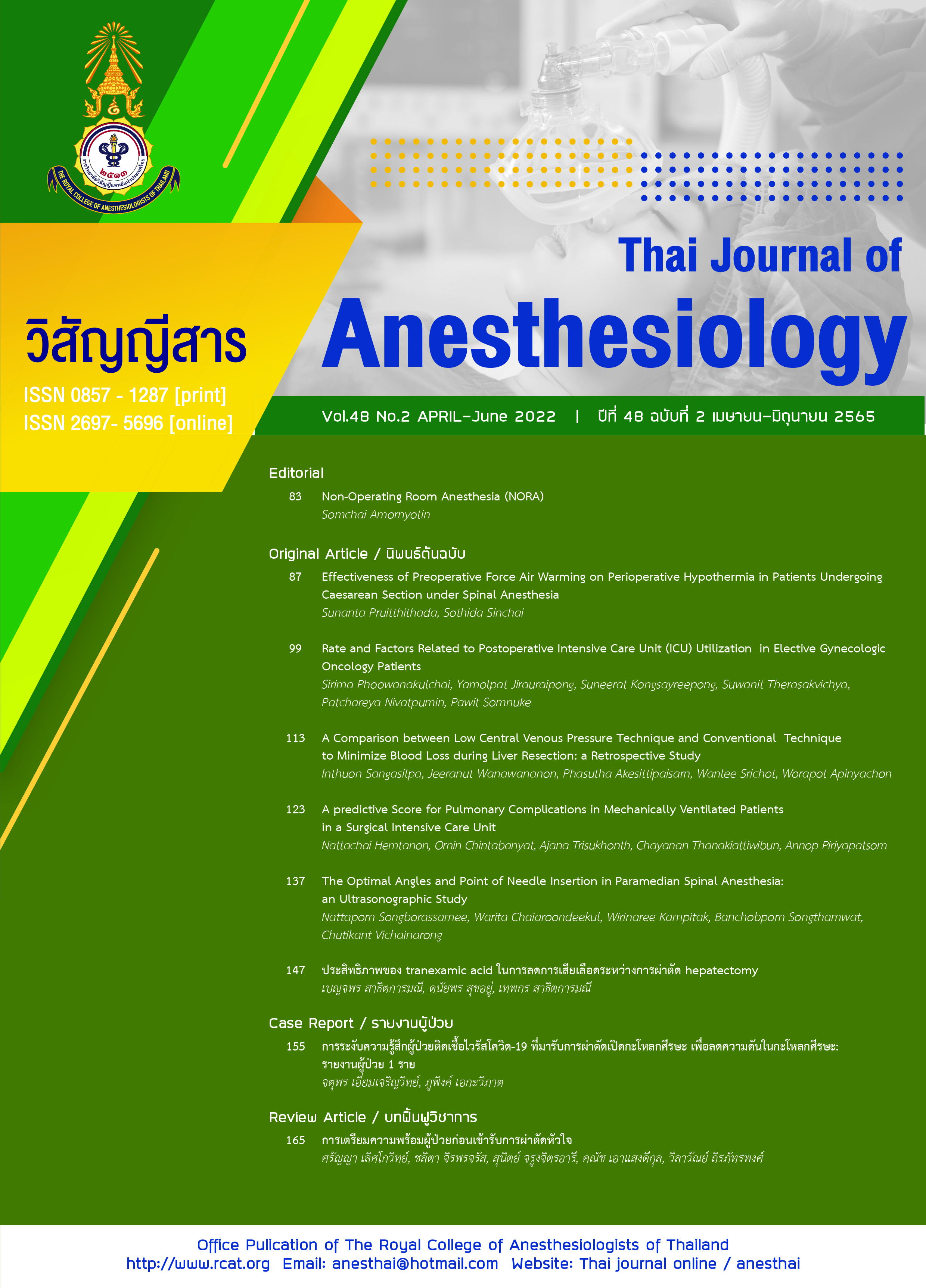A Comparison between Low Central Venous Pressure Technique and Conventional Technique to Minimize Blood Loss during Liver Resection: a Retrospective Study
Main Article Content
Abstract
Background: The Low central venous pressure (LCVP) technique has been accepted as a method to minimize blood loss during liver resection. The LCVP technique intends to control the CVP levels at less than 5 mmHg. However, this technique may cause hemodynamic instability and renal complications. Objective: This retrospective study aimed to demonstrate the benefit of the LCVP technique in terms of blood loss, vasopressors requirement, an incidence of acute kidney injury compared to the conventional technique in liver resection surgery. Methods: After approval of IRB, the data of patients who underwent liver resection were divided into two groups; the LCVP and conventional groups. Demographic data, intraoperative vasopressors requirements, estimated blood loss (EBL), packed red blood cell (PRBC) transfusion and serum creatinine were reviewed retrospectively. Results: One hundred thirteen patients underwent liver resection; 57 patients received the LCVP technique while conventional technique applied to 56 patients. EBL in conventional technique group was 700 (500-1400) mL whereas in LCVP technique group was 400 (200-575) mL (P=0.001). Eleven (19.3%) patients in LCVP group required PRBC transfusion whereas 21 (37.5%) patients in conventional group (P=0.032). There was no significant difference in vasopressor requirement between groups. Lastly, the incidence of acute kidney injury (AKI) in the conventional group and the LCVP group were 3 (5.4%) and 3 (5.3%) respectively (P=0.982). Conclusion: This study demonstrated the benefit of the LCVP technique in reducing blood loss and PRBC transfusion. There was no increase in vasopressor requirements or incidence of AKI in the LCVP technique compared to the conventional technique in liver resection.
Article Details

This work is licensed under a Creative Commons Attribution-NonCommercial-NoDerivatives 4.0 International License.
References
Yamamoto J, Kosuge T, Takayama T, et al. Perioperative blood transfusion promotes recurrence of hepatocellular carcinoma after hepatectomy. Surgery. 1994;115:303-9.
Li Z, Sun YM, Wu FX, Yang LQ, Lu ZJ, Yu WF. Controlled low central venous pressure reduces blood loss and transfusion requirements in hepatectomy. World J Gastroenterol. 2014;20:303-9.
Correa-Gallego C, Berman A, Denis SC, et al. Renal function after low central venous pressure-assisted liver resection: assessment of 2116 cases. HPB (Oxford). 2015;17:258-64.
Yu L, Sun H, Jin H, Tan H. The effect of low central venous pressure on hepatic surgical field bleeding and serum lactate in patients undergoing partial hepatectomy: a prospective randomized controlled trial. BMC Surg. 2020;20:25.
Sand L, Lundin S, Rizell M, Wiklund J, Stenqvist O, Houltz E. Nitroglycerine and patient position effect on central, hepatic and portal venous pressures during liver surgery. Acta Anaesthesiol. Scand 2014;58:961-7.
Ryu HG, Nahm FS, Sohn HM, Jeong EJ, Jung CW. Low central venous pressure with milrinone during living donor hepatectomy. Am J Transplant. 2010;10:877-82.
Wang WD, Liang LJ, Huang XQ, Yin XY. Low central venous pressure reduces blood loss in hepatectomy. World J Gastroenterol. 2006;12:935-9.
McNally SJ, Revie EJ, Massie LJ, et al. Factors in perioperative care that determine blood loss in liver surgery. HPB. 2012;14:236-41.
Kubo S, Takemura S, Yamamoto S, et al. Risk factors for massive blood loss during liver resection for hepatocellular carcinoma in patients with cirrhosis. Hepatogastroenterology. 2007;54:830-3.
Leelanukrom R, Songthamwat B, Thonnagith A, Narkburin S. Factors affecting intraoperative blood loss during liver resection. J Med Assoc Thai. 2013;96:58-63.
Hughes MJ, Ventham NT, Harrison EM, Wigmore SJ. Central venous pressure and liver resection: a systematic review and meta-analysis. HPB (Oxford). 2015;17:863-71.
McNally SJ, Revie EJ, Massie LJ, et al. Factors in perioperative care that determine blood loss in liver surgery. HPB (Oxford). 2012;14:236-41.
Yu L, Sun H, Jin H, Tan H. The effect of low central venous pressure on hepatic surgical field bleeding and serum lactate in patients undergoing partial hepatectomy: a prospective randomized controlled trial. BMC Surg. 2020;20:25-9.
Li Z, Sun Y-M, Wu F-X, Yang L-Q, Lu Z-J, Yu W-F. Controlled low central venous pressure reduces blood loss and transfusion requirements in hepatectomy. World J Gastroenterol. 2014;20:303-9.
McNally SJ, Revie EJ, Massie LJ, et al. Factors in perioperative care that determine blood loss in liver surgery. HPB (Oxford). 2012;14:236-41.
Yamamoto Y, Ikoma H, Morimura R, et al. Predictive scoring system assessing the need for intraoperative blood transfusions during hepatectomy for hepatocellular carcinoma. Anticancer Res. 2014;34:313-8.
Cockbain AJ, Masudi T, Lodge JP, Toogood GJ, Prasad KR. Predictors of blood transfusion requirement in elective liver resection. HPB (Oxford). 2010;12:50-5.
Ishikawa S, Tanaka M, Maruyama F, et al. Effects of acute kidney injury after liver resection on long-term outcomes. Korean J Anesthesiol. 2017;70:527-34.
Bressan AK, James MT, Dixon E, Bathe OF, Sutherland FR, Ball CG. Acute kidney injury following resection of hepatocellular carcinoma: prognostic value of the acute kidney injury network criteria. Can J Surg. 2018;61:E11-6.
Erdost HA, Ozkardesler S, Akan M, et al. Comparison of the RIFLE, AKIN, and KDIGO Diagnostic Classifications for Acute Renal Injury in Patients Undergoing Liver Transplantation. Transplant Proc. 2016;48:2112-8.


